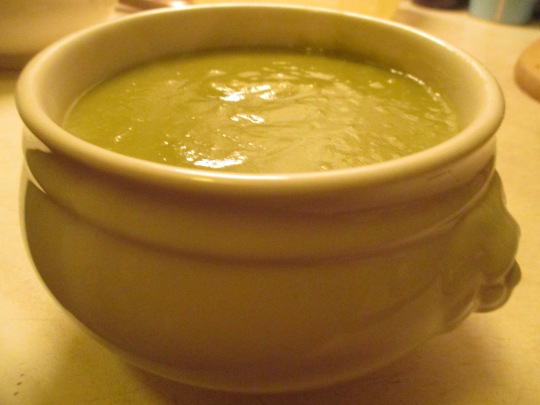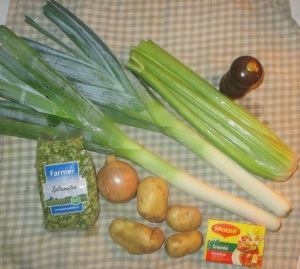 Finally some time for a new vegan recipe! I have had many requests for a vegan recipe of a typical Dutch soup: split pea soup! A vegan split pea soup is in fact really easy to make, by simply leaving out meat from traditional recipes. Split pea soup is delicious now we’re in Fall again and the days are getting colder and darker. Enjoy!
Finally some time for a new vegan recipe! I have had many requests for a vegan recipe of a typical Dutch soup: split pea soup! A vegan split pea soup is in fact really easy to make, by simply leaving out meat from traditional recipes. Split pea soup is delicious now we’re in Fall again and the days are getting colder and darker. Enjoy!
Ingredients
 300 grams split peas
300 grams split peas- 2 liter vegetable broth or stock (or use 2 liters water with cubes of vegetable broth)
- 1 onion
- 3 stalks of (shrub) celery
- 3 leeks
- 4 (floury) potatoes
- 1 big carrot
- black pepper to taste
Preparation:
- Wash the split peas by putting them in water in a saucepan, shaking the pan with the cover on it, and then drain the water out. Do this several times until the water remains clear.
- Put the split peas in a large pan with about 2 liters of water and put them on high heat. As soon as the water is boiling, stir in the cubes of vegetable broth. (Or use 2 liters of your own homemade vegetable broth). Put the heat on low and let the peas cook until almost tender.
- Chop the onion, the stalks of celery, the leeks, the potatoes and the carrot (doesn’t have to be chopped finely). When the split peas are almost tender, add all the chopped vegetables to the soup, increase the heat until the soup boils.
- Reduce heat to low again, cover, and continue to cook until everything is tender (check and stir regularly).
- Let the soup cool off and then blend in a food processor. If you don’t want a completely smooth soup, don’t blend the whole soup.
- Heat the soup again till it’s nicely hot and add black pepper to taste. Bon appetit!
Traditionally, the Dutch eat split pea soup with rookworst or smoked sausage. Like most meats, there are now meat replacements available for smoked sausage. Though these are vegetarian, they are not completely vegan yet, as chicken egg white is used in it. However, you can use any vegan meat replacement that you like and add it to the soup at the end. You can also try it without any meat replacement, and you will see that split pea soup is delicious as it is!
—-
Veganistische erwtensoep
Eindelijk tijd voor weer eens een nieuw veganistisch recept! Al vaak kreeg ik van mensen het verzoek voor een recept voor veganistische snert of erwtensoep. In feite heel makkelijk te maken door de rookworst of ander vlees gewoon weg te laten. Erwtensoep is zalig nu we weer in de herfst zitten en de dagen koud en donker worden. Geniet ervan!
Ingredienten
 300 gram spliterwten
300 gram spliterwten- 2 liter groentebouillon (of 2 liter water met groentebouillonblokjes)
- 1 ui
- 3 stengels bleekselderij
- 3 prei
- 4 kruimige aardappelen
- 1 winterpeen of andere wortels
- zwarte peper naar smaak
Bereidingswijze:
- Was eerst de spliterwten door deze herhaald in een pan met water te stoppen, te schudden met het deksel erop, en dan het water af te gieten. Net zo lang tot het water min of meer helder is geworden.
- Doe de erwten in een grote pan met ongeveer 2 liter water en zet ze op hoog vuur. Doe er zodra het water kookt vier groentebouillontabletten in. (Of je kunt een zelfgemaakt groentesoepje van 2 liter toevoegen aan de erwten in plaats van het water). Zet het vuur laag en laat de erwten vrolijk garen.
- Snijd de ui, de stengels selderij, de prei, de aardappels en de wortel in grove stukken. Doe deze zodra de erwten een beetje gaar zijn in de grote pan en breng alles weer even aan de kook.
- Zet het vuur weer laag, doe het deksel op de pan en laat alles rustig doorkoken tot de groente en de erwten gaar genoeg zijn (regelmatig even checken en roeren).
- Haal van het vuur af en laat de soep afkoelen en pureer deze vervolgens in een blender of mixer. Als je niet een volledig egale soep wilt hebben, pureer dan niet de hele soep.
- Verwarm de gepureerde soep tot ‘ie goed heet is en voeg naar smaak nog (verse) zwarte peper toe. Eet smakelijk!
Helaas is er nog geen volledig veganistische rookworst op de markt. Er zijn wel vegetarische rookworsten, maar daar zit kippenei-eiwit in. In plaats van rookworst kun je elke veganistische vleesvervanger gebruiken waar je maar zin in hebt en die aan het eind toevoegen aan de soep. Probeer het ook eens zonder enige vleesvervanger, dan zul je zien dat snert ook zonder heerlijk is!
























